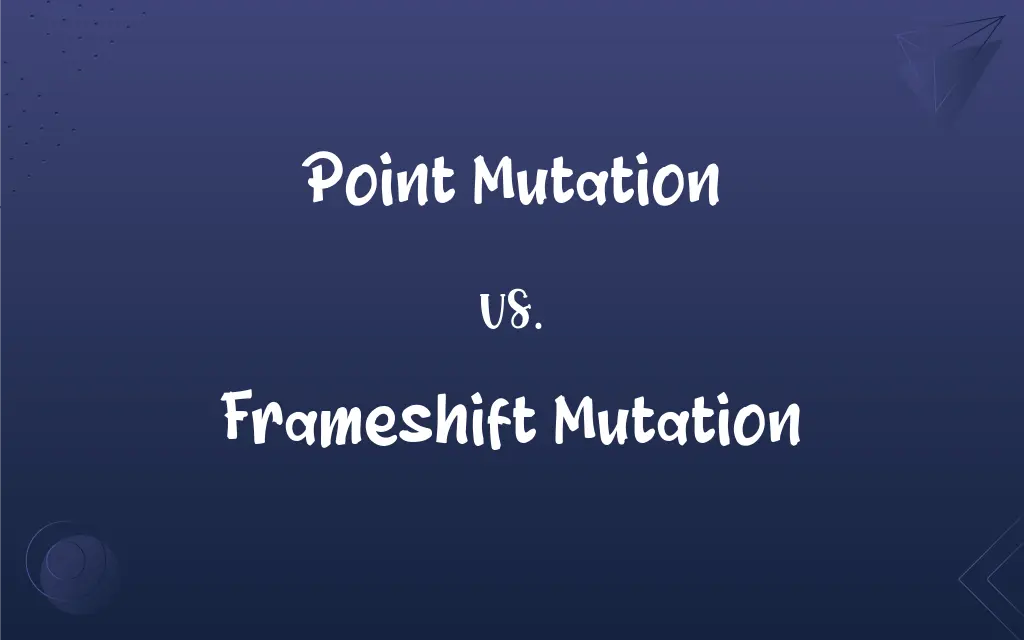Point Mutation vs. Frameshift Mutation: What's the Difference?
Edited by Janet White || By Harlon Moss || Updated on October 29, 2023
A point mutation alters a single nucleotide, while a frameshift mutation adds or deletes nucleotides, shifting the reading frame.

Key Differences
Point mutations and frameshift mutations represent two distinct types of genetic changes that can occur within DNA sequences. A point mutation refers to a change in a single nucleotide base pair, which can lead to the production of a different amino acid in the resultant protein. In contrast, a frameshift mutation results from the insertion or deletion of nucleotides, causing a shift in the DNA's reading frame.
Point mutations, being localized to a single nucleotide change, might result in the same, a different, or even a stop amino acid. Depending on the nature of this amino acid change, the protein's function could remain unaffected, be altered, or become nonfunctional. Frameshift mutations, on the other hand, have more extensive consequences. Because they alter the reading frame, they often produce entirely different amino acid sequences from the mutation point onward, which typically leads to nonfunctional proteins.
While both point mutations and frameshift mutations can have significant effects on an organism's phenotype, frameshift mutations tend to have more dramatic impacts. This is because the reading frame shift can affect numerous downstream codons and create substantially altered proteins. Point mutations, on the other hand, might sometimes be silent, meaning they don't change the encoded amino acid and hence don't impact the protein's function.
It's essential to understand that both point mutations and frameshift mutations can occur spontaneously or be induced by mutagens, external factors that cause mutations. While point mutations alter a single site, frameshift mutations can set off a cascade of changes in the amino acid sequence, usually leading to early termination of the protein due to the appearance of a stop codon.
In conclusion, while point mutations focus on singular nucleotide changes and can have varied effects, frameshift mutations, due to their alteration of the reading frame, typically result in larger-scale protein disruptions. Both mutations highlight the delicate nature of DNA and its coding potential.
ADVERTISEMENT
Comparison Chart
Definition
Single nucleotide change
Insertion or deletion of nucleotides
Impact on Reading Frame
Does not shift
Shifts reading frame
Resultant Protein Change
May or may not alter protein function
Typically produces nonfunctional proteins
Cause
Spontaneous or induced
Spontaneous or induced
Example
Substitution of A for G
Deletion of a nucleotide causing downstream changes
ADVERTISEMENT
Point Mutation and Frameshift Mutation Definitions
Point Mutation
A localized genetic change affecting one nucleotide.
UV light can induce point mutations in skin cells.
Frameshift Mutation
A change disrupting the triple-nucleotide codon pattern.
The insertion of a nucleotide can trigger a frameshift mutation.
Point Mutation
Genetic alteration at a specific location on the DNA.
A point mutation might convert a codon to a stop codon.
Frameshift Mutation
Mutation that shifts the reading frame of codons.
Frameshift mutations typically result in nonfunctional proteins.
Point Mutation
A change in a single nucleotide within a DNA sequence.
Sickle cell anemia is caused by a point mutation in the hemoglobin gene.
Frameshift Mutation
Genetic change with cascading effects on the protein.
A small frameshift mutation can impact a protein's entire structure.
Point Mutation
A minimal mutation that doesn't change the reading frame.
Point mutations can sometimes result in no change in the encoded protein.
Frameshift Mutation
Genetic alteration caused by nucleotide insertions or deletions.
A frameshift mutation can lead to an entirely different protein sequence.
Point Mutation
One base pair substitution in a gene.
Certain cancers are linked to specific point mutations.
Frameshift Mutation
Mutation not in multiples of three nucleotides.
Deleting two nucleotides will result in a frameshift mutationa.
FAQs
What is a point mutation?
A point mutation is a change in a single nucleotide in a DNA sequence.
How does a frameshift mutation occur?
A frameshift mutation occurs due to the insertion or deletion of nucleotides.
Which mutation has more dramatic impacts generally?
Frameshift mutations usually have more dramatic impacts than point mutations.
What's the typical result of a frameshift mutation?
Frameshift mutations often produce nonfunctional or drastically altered proteins.
Can a point mutation be silent?
Yes, if the point mutation doesn't change the encoded amino acid, it's considered silent.
Can point mutations cause diseases?
Yes, diseases like sickle cell anemia are caused by point mutations.
How can point mutations be detected?
Techniques like DNA sequencing can detect point mutations.
How do frameshift mutations affect protein synthesis?
They can alter the amino acid sequence from the mutation point, often leading to early termination.
Can point mutations occur in any cell?
Yes, point mutations can occur in any cell type, whether somatic or germinal.
What is a missense mutation?
It's a type of point mutation where one amino acid is replaced by another.
What causes a frameshift mutation?
Insertions or deletions of nucleotides in DNA cause frameshift mutations.
Can frameshift mutations be repaired?
While cells have DNA repair mechanisms, not all frameshift mutations are repaired.
How do frameshift mutations relate to genetic disorders?
Many genetic disorders arise from frameshift mutations due to protein dysfunction.
Can a frameshift mutation be beneficial?
It's rare, but certain frameshift mutations might offer advantages in specific environments.
Can environmental factors induce point mutations?
Yes, mutagens like radiation or chemicals can induce point mutations.
Are point mutations more common than frameshift mutations?
Point mutations generally occur more frequently than frameshift mutations.
Is a base pair substitution a point mutation?
Yes, a base pair substitution is an example of a point mutation.
Are all point mutations harmful?
No, some point mutations are silent or neutral, having no noticeable effect.
What's the main consequence of frameshift mutations on genes?
A major consequence is the disruption of the codon reading frame.
Are frameshift mutations always harmful?
While not always, frameshift mutations typically result in nonfunctional proteins and are often harmful.
About Author
Written by
Harlon MossHarlon is a seasoned quality moderator and accomplished content writer for Difference Wiki. An alumnus of the prestigious University of California, he earned his degree in Computer Science. Leveraging his academic background, Harlon brings a meticulous and informed perspective to his work, ensuring content accuracy and excellence.
Edited by
Janet WhiteJanet White has been an esteemed writer and blogger for Difference Wiki. Holding a Master's degree in Science and Medical Journalism from the prestigious Boston University, she has consistently demonstrated her expertise and passion for her field. When she's not immersed in her work, Janet relishes her time exercising, delving into a good book, and cherishing moments with friends and family.































































